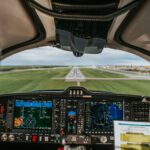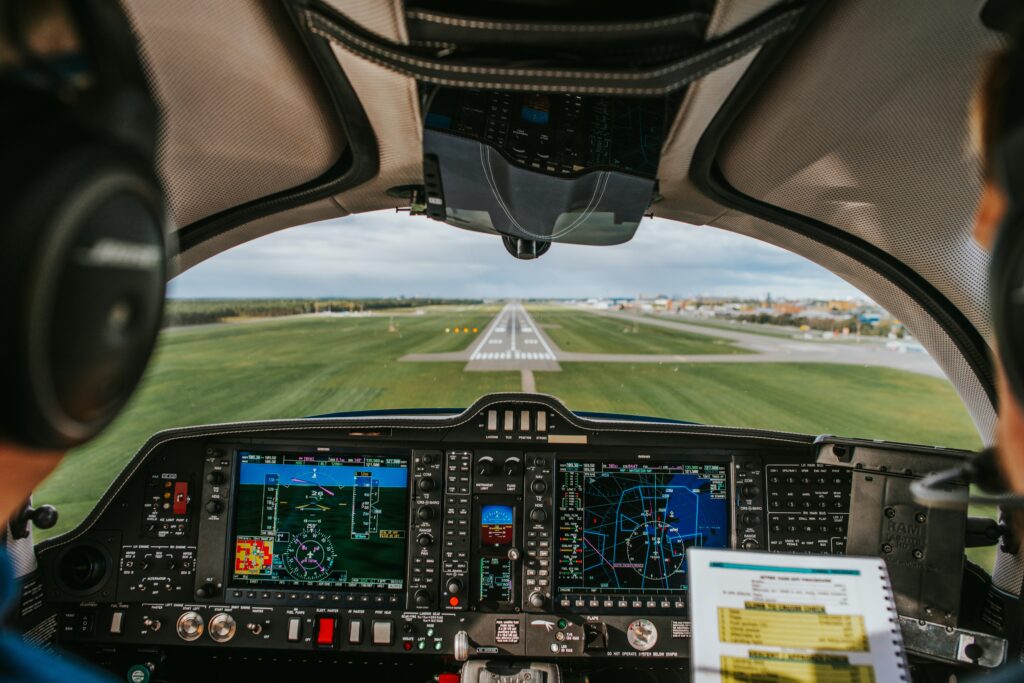Are you dreaming of soaring through the skies as a pilot? If so, you’ve come to the right place. In this comprehensive guide, we’ll explore the steps to becoming a pilot and provide valuable insights into the exciting world of aviation. From researching pilot schools to completing the necessary training and certifications, we’ll cover it all. Whether you aspire to fly for the U.S. Air Force or pursue a career as a civilian pilot, we’ve got you covered. So buckle up and get ready to embark on an exhilarating journey towards your pilot’s license.
Key Takeaways
- Research and compare pilot schools to find the best program for your aviation goals.
- Take an admissions flight to experience the training, aircraft, and quality of instruction offered by a flight school.
- Complete the necessary steps to obtain FAA medical and student pilot certificates.
- Begin flight training lessons and work towards gaining aeronautical knowledge and pilot training experience.
- Pass the FAA private pilot knowledge test and practical exam to earn your private pilot certificate.
Researching Pilot Schools and Programs
When embarking on the journey to become a pilot, it is crucial to thoroughly research pilot schools and programs to find the best match for your aviation goals. With the myriad of options available, it can be overwhelming to determine which program will provide the necessary training, resources, and support to help you succeed in your aviation career. In this section, we will explore the key steps to effectively research and evaluate pilot schools and programs.
Comparing Available Pilot Schools
The first step in researching pilot schools is to compile a list of available options. This can be done by utilizing online resources, such as aviation directories and websites, to identify schools that offer pilot training programs. Take into consideration factors such as location, reputation, accreditation, and the specific types of pilot licenses or certifications they offer.
Once you have compiled a list of potential pilot schools, it’s time to compare them. Look for information on the curriculum, flight training facilities, aircraft fleet, instructor qualifications, and student success rates. Additionally, read reviews and testimonials from current and former students to gain insights into their experiences and the overall quality of the program.
Choosing the Best Program for Your Aviation Goals
After comparing pilot schools, it’s important to evaluate which program aligns best with your aviation goals. Consider factors such as the type of pilot license or certification you wish to obtain, the duration of the program, and any additional training or specialized courses offered. Some pilot schools may have partnerships with airlines or offer job placement assistance, which can be advantageous for those seeking employment opportunities after completing their training.
Furthermore, take into account the financial aspect of pilot training. Research the tuition fees, available scholarships or financial aid options, and any additional costs such as housing or transportation. It’s crucial to have a clear understanding of the financial commitment required to complete the program.
To make an informed decision, reach out to the admissions offices of the pilot schools you are considering. Schedule tours, attend open houses, and ask questions about the program structure, training methodologies, and opportunities for hands-on experience. Gathering firsthand information will provide valuable insights into the culture and learning environment of each pilot school.
Taking Admissions Flight for Firsthand Experience
One highly recommended step in the research process is to take an admissions flight at the pilot schools you are seriously considering. This offers a firsthand experience of the training, aircraft, and quality of instruction offered by the flight school. During the admissions flight, you will have the opportunity to interact with instructors, ask questions, and get a sense of the overall atmosphere.
When scheduling your admissions flight, be prepared to demonstrate your commitment and passion for aviation. Dress professionally, arrive on time, and come prepared with any questions or concerns you may have. Treat the admissions flight as an opportunity to showcase your enthusiasm and dedication to becoming a pilot.
In conclusion, researching pilot schools and programs is a crucial step in your journey to becoming a pilot. By comparing available pilot schools, choosing the best program for your aviation goals, and taking admissions flights for firsthand experience, you will be equipped to make an informed decision that sets you on the path to success in your aviation career.
Obtaining FAA Certificates and Documents
The process of becoming a pilot involves obtaining various FAA certificates and documents. These credentials are essential for ensuring the safety and competency of pilots. In this section, we will discuss the steps required to obtain an FAA medical certificate, an FAA student pilot certificate, and provide an overview of the IACRA website process.
Applying for an FAA Medical Certificate
Before embarking on your journey to become a pilot, it is crucial to apply for an FAA medical certificate. This certificate ensures that you meet the medical standards necessary for safe flight operations. The requirements for this certificate are more stringent for those aspiring to fly professionally. Therefore, it is essential to familiarize yourself with the specific guidelines outlined by the FAA.
Applying for an FAA Student Pilot Certificate
Once you have obtained your FAA medical certificate, the next step is to apply for an FAA student pilot certificate. The application process for this certificate can be done conveniently through the IACRA (Integrated Airman Certification and Rating Application) website. The student pilot certificate allows you to receive flight training and gain the necessary aeronautical knowledge and pilot training experience.
Understanding the IACRA Website Process
The IACRA website plays a vital role in the application process for various FAA certificates and documents. To apply for an FAA student pilot certificate, you will need to navigate through the IACRA website and complete the required forms. It is crucial to familiarize yourself with the website’s functionality and follow the step-by-step instructions provided.
The IACRA website process ensures a streamlined and efficient application process. However, it is important to note that the website’s functionality and requirements may evolve over time. Therefore, it is recommended to stay updated with the latest information and guidelines provided by the FAA.
In conclusion, obtaining FAA certificates and documents is an integral part of becoming a pilot. By applying for an FAA medical certificate, an FAA student pilot certificate, and understanding the IACRA website process, aspiring pilots can ensure they meet the necessary requirements and embark on their journey towards achieving their aviation goals.
Starting Flight Training Lessons
Working towards aeronautical knowledge
Becoming a pilot is a dream for many aviation enthusiasts. However, embarking on this journey requires dedication, effort, and a thirst for knowledge. To start your flight training lessons, it is crucial to lay a solid foundation of aeronautical knowledge.
The first step is to research pilot schools and compare the available programs to find the best match for your aviation goals. Look for schools that have experienced instructors, a well-maintained fleet of aircraft, and a comprehensive curriculum. Taking an admissions flight at your chosen flight school will give you a firsthand experience of the training, aircraft, and quality of instruction offered.
Once you have chosen a flight school, the next step is to apply for an FAA medical certificate. The medical standards are higher for those wanting to fly professionally, so it is important to undergo the necessary medical examinations to ensure you meet the requirements.
Additionally, you need to apply for an FAA student pilot certificate through the Integrated Airman Certification and Rating Application (IACRA) website. This certificate allows you to fly solo under the supervision of a flight instructor.
Gaining pilot training experience
To become a pilot, you must gain valuable training experience. This involves starting flight training lessons at your chosen flight school. These lessons will help you develop the necessary skills and knowledge to navigate the skies with confidence.
During your flight training, you will work towards obtaining the necessary aeronautical knowledge required to become a pilot. This includes learning about aerodynamics, aviation weather, navigation, airspace, and regulations. Your flight instructor will guide you through the curriculum and provide hands-on training to ensure you are well-prepared for the challenges of flying.
As part of your training, you will also need to pass the computer-based FAA private pilot knowledge test. This test assesses your understanding of various aviation topics and requires an endorsement from your flight instructor to be eligible to take it. Once you have successfully passed the knowledge test, you will be one step closer to obtaining your FAA private pilot certificate.
Enrolling in flight training courses
Enrolling in flight training courses is a crucial step towards becoming a pilot. These courses provide you with the practical skills and experience needed to operate an aircraft safely and efficiently.
The FAA’s rules for getting a pilot’s license differ depending on the type of aircraft you want to fly. There are different types of pilot’s licenses, from student pilot to airline transport pilot. Each license has its own eligibility, training, experience, and testing requirements.
Whether you aspire to be a student pilot, recreational pilot, or private pilot, it is important to familiarize yourself with the specific requirements for each type of license. This will ensure that you are on the right track and can progress through your flight training efficiently.
If you have any further questions or need more information, you can reach out to the FAA Flight Standards District Office. They will be able to provide you with the necessary guidance and support on your journey to becoming a pilot.
Remember, becoming a pilot requires dedication, perseverance, and a commitment to continuous learning. By working towards aeronautical knowledge, gaining pilot training experience, and enrolling in flight training courses, you will be well on your way to achieving your dream of taking to the skies as a pilot.
Passing Exams and Obtaining Certifications
Preparing for the FAA Private Pilot Knowledge Test
Before becoming a pilot, aspiring aviators must pass the FAA private pilot knowledge test. This comprehensive exam evaluates a candidate’s understanding of aeronautical knowledge and regulations. To prepare for this test, it is crucial to study diligently and acquire the necessary knowledge.
One effective way to prepare is by enrolling in a reputable pilot school. Research various pilot schools and compare their programs to find the best fit for your aviation goals. Consider factors such as the quality of instruction, training aircraft, and the overall reputation of the institution. Additionally, taking an admissions flight can provide a firsthand experience of the training environment and help you make an informed decision.
As you embark on your pilot training journey, obtaining an FAA medical certificate is a crucial step. Depending on your aspirations in aviation, different medical certificate classes may be required. Professional pilots, for instance, must meet higher medical standards. Be sure to apply for the appropriate certificate and undergo the necessary medical examinations.
Another essential requirement is obtaining an FAA student pilot certificate. This can be done through the Integrated Airman Certification and Rating Application (IACRA) website. The student pilot certificate allows you to begin your flight training lessons and gain the necessary experience to become a certified pilot.
Earning an Endorsement from Your Flight Instructor
To be eligible to take the FAA private pilot knowledge test, you must receive an endorsement from your flight instructor. This endorsement signifies that you have completed the necessary training and are adequately prepared for the exam. Your flight instructor will assess your knowledge and skills, ensuring that you are ready to tackle the test.
During your flight training lessons, your instructor will cover aeronautical knowledge topics, including airspace regulations, weather patterns, navigation, and emergency procedures. It is essential to pay close attention and actively participate in these lessons to maximize your chances of success on the knowledge test.
Once your flight instructor deems you ready, they will provide you with the endorsement required to register for the FAA private pilot knowledge test. This endorsement serves as a validation of your preparedness and is a crucial step towards obtaining your private pilot certificate.
Taking the Practical Exam with a Designated Pilot Examiner
After passing the FAA private pilot knowledge test, the next step towards becoming a pilot is taking the practical exam. This exam is conducted by a Designated Pilot Examiner (DPE) and assesses your ability to apply your knowledge and skills in a real-world flight scenario.
The practical exam involves both a flight portion and an oral examination. During the flight portion, you will demonstrate your proficiency in various maneuvers, including takeoffs, landings, navigation, and emergency procedures. The DPE will evaluate your decision-making skills, ability to handle different flight situations, and adherence to aviation regulations.
In the oral examination, the DPE will assess your aeronautical knowledge, asking questions about flight planning, aircraft systems, weather interpretation, and other relevant topics. It is crucial to thoroughly study and review all applicable material to confidently answer these questions.
Upon successful completion of the practical exam, the DPE will issue your FAA private pilot certificate. This certificate grants you the authority to fly as a private pilot, allowing you to pursue your aviation goals and embark on exciting adventures in the skies.
Remember, becoming a pilot requires dedication, discipline, and a commitment to continuous learning. By following the necessary steps, preparing diligently, and demonstrating your skills during the exams, you can achieve your dream of becoming a certified pilot.
Meeting Educational Requirements
Understanding the Minimum Education Requirement
Becoming a pilot requires a strong educational foundation. The minimum education requirement to pursue a career as a pilot is a Bachelor’s degree. This ensures that aspiring pilots have a well-rounded knowledge base and the intellectual skills necessary for success in the field. While the specific field of study is not specified, it is beneficial for aspiring pilots to pursue degrees in aviation, aerospace engineering, or a related field. These programs provide a comprehensive understanding of aviation principles, aircraft systems, and navigation techniques.
Completing Air Force Specialized Undergraduate Pilot Training
For those interested in becoming a pilot in the Air Force, completion of Air Force Specialized Undergraduate Pilot Training (SUPT) is a requirement. This rigorous program is designed to equip aspiring pilots with the necessary skills and knowledge to operate military aircraft. SUPT consists of both classroom instruction and practical flight training, ensuring that pilots are well-prepared for the challenges they will face in the field.
The Importance of Officer Training School (OTS)
In addition to completing Air Force SUPT, aspiring Air Force pilots must also complete Officer Training School (OTS). OTS is a comprehensive program that focuses on developing leadership skills and preparing individuals for the responsibilities of an officer in the Air Force. This training is essential for pilots as they will not only be responsible for operating aircraft but also leading and managing their fellow airmen.
OTS lasts for 8.5 weeks and is conducted at Maxwell Air Force Base in Alabama. During this intense training program, aspiring pilots will undergo physical fitness training, leadership development exercises, and classroom instruction on topics such as military ethics and Air Force policies. Successful completion of OTS is a crucial step towards becoming an Air Force pilot.
In summary, meeting the educational requirements to become a pilot involves obtaining a Bachelor’s degree, completing Air Force Specialized Undergraduate Pilot Training, and successfully finishing Officer Training School. These educational milestones lay the foundation for a successful career in aviation and ensure that aspiring pilots have the necessary skills and knowledge to excel in their field.
Qualifying for Air Force Pilot Training
Becoming an Air Force pilot is a dream shared by many aspiring aviators. The thrill of soaring through the skies, the sense of adventure, and the opportunity to serve your country all make it an attractive career path. However, the road to becoming an Air Force pilot is not an easy one. It requires dedication, commitment, and meeting strict qualifications. In this article, we will discuss the requirements and steps involved in qualifying for Air Force pilot training.
Age Requirements for Pilot Training
To be eligible for Air Force pilot training, aspiring pilots must have begun their training between the ages of 18 and 33. This age range ensures that candidates have the physical stamina and cognitive abilities necessary to handle the demands of flying. It’s important to note that age waivers may be available for exceptional candidates, but they are granted on a case-by-case basis.
Height Specifications and Aviation Career Opportunities
Height specifications for Air Force pilots vary depending on the aircraft they will be flying. While there are different requirements for different aircraft, most applicants can pursue a career in aviation with the U.S. Air Force. It’s essential to meet the height requirements specified for the desired aircraft to ensure optimal performance and safety during flight operations.
The Process of Completing Officer Training and Flight Training
Becoming an Air Force pilot not only requires completing flight training but also going through the process of officer training. The first step is to complete Officer Training School (OTS), Air Force Academy (AFA), or Air Force Reserve Officer Training Corps (AFROTC). These programs provide the necessary foundation in leadership, discipline, and military knowledge required to serve as an officer in the Air Force.
After completing officer training, aspiring pilots enter Undergraduate Pilot Training (UPT). UPT is a rigorous program that combines classroom instruction, simulator training, and actual flight time to develop the skills and knowledge needed to become a pilot. The training program lasts approximately one year and covers a wide range of subjects, including aerodynamics, navigation, aircraft systems, and emergency procedures.
Once UPT is successfully completed, pilots are assigned to a specific aircraft and undergo further flight training for that particular platform. The duration and intensity of this training vary depending on the aircraft type. Throughout the training process, pilots are evaluated on their performance and must meet the required standards to progress to the next stage.
Conclusion
Qualifying for Air Force pilot training is a challenging but rewarding journey. It requires meeting strict age, height, physical, medical, vision, and academic requirements. Additionally, completing officer training and flight training is crucial to becoming an Air Force pilot. Aspiring pilots should thoroughly research pilot schools, compare available programs, and seek firsthand experiences to find the best match for their aviation goals. By following the necessary steps and demonstrating dedication, aspiring aviators can turn their dreams of becoming Air Force pilots into a reality. For further information, the FAA Flight Standards District Office can provide additional guidance and support.
Meeting Physical and Academic Requirements
Strict requirements for physical and medical conditions
Becoming a pilot requires more than just a passion for flying. It also demands meeting strict physical and medical requirements. These requirements are in place to ensure the safety and well-being of both the pilot and passengers. Aspiring pilots must undergo thorough medical examinations to assess their overall health and ability to handle the physical demands of flying.
The Federal Aviation Administration (FAA) sets the standards for physical and medical conditions. These standards vary depending on the type of pilot certification one wishes to obtain. For those aspiring to fly professionally, such as airline pilots, the requirements are even more stringent.
Among the physical requirements for pilots are normal color vision, near visual acuity of 20/30 without correction, and distance visual acuity of no worse than 20/70 in each eye, correctable to 20/20. Additionally, pilots must meet other criteria related to refraction, accommodation, and astigmatism.
Visual acuity and color vision standards
Visual acuity refers to the sharpness and clarity of one’s vision. Pilots must have excellent visual acuity to ensure they can accurately read instruments, charts, and other critical information while in flight. The FAA mandates that pilots have a near visual acuity of at least 20/30 without correction. This means they should be able to see objects clearly at a distance of 20 feet that individuals with normal vision can see at 30 feet.
Color vision is another crucial aspect of a pilot’s visual capabilities. Pilots must have normal color vision to accurately identify the colors used in aviation lighting systems, instrument displays, and other visual cues. The FAA requires pilots to pass a color vision test to ensure they can differentiate between colors effectively.
Understanding the service commitments for pilots
Becoming a pilot in the Air Force entails not only meeting the physical and medical requirements but also understanding the service commitments involved. The commitment for an Air Force pilot is 10 years of active-duty service after the completion of pilot training. This commitment ensures that the Air Force can make the most of the extensive training and investment put into developing its pilots.
For those interested in pursuing a career as an Air Force pilot, it is essential to know the various steps involved in the process. These steps include completing officer training, entering Undergraduate Pilot Training (UPT), receiving a seat assignment, and undergoing flight training for the assigned aircraft.
Officer Training School (OTS) is an 8.5-week program located at Maxwell AFB AL. Completion of OTS, Air Force Academy (AFA), or Air Force Reserve Officer Training Corps (AFROTC) is necessary to become an Air Force pilot. It is also crucial to begin pilot training between the ages of 18 and 33 to be eligible for the program.
In addition to the service commitments, aspiring pilots must have a Bachelor’s degree and meet height specifications, which can vary depending on the aircraft. However, most applicants can pursue a career in aviation with the U.S. Air Force, given the range of aircraft available.
Navigators have a six-year service commitment, while pilots have a 10-year service commitment. These commitments reflect the investment made by the Air Force in training and developing skilled pilots and navigators.
In conclusion, becoming a pilot requires not only fulfilling the academic requirements but also meeting strict physical, medical, and vision standards. The commitment to serve in the Air Force is a significant aspect of the process, ensuring that pilots are dedicated and capable of fulfilling their duties. By understanding and meeting these requirements, aspiring pilots can embark on a rewarding career in aviation.
Frequently Asked Questions
Research pilot schools and compare available programs to find the best match for your aviation goals.
Take an admissions flight to get a firsthand experience of the training, aircraft, and quality of instruction offered by a flight school.
Apply for an FAA medical certificate, with higher standards for those wanting to fly professionally. Also, apply for an FAA student pilot certificate through the IACRA website.
Start flight training lessons to work towards obtaining the necessary aeronautical knowledge and pilot training experience.
Pass the computer-based FAA private pilot knowledge test, with an endorsement from your flight instructor. Then, take a practical exam with a Designated Pilot Examiner to earn your FAA private pilot certificate.
Yes, a minimum education requirement is a Bachelor’s degree.
Completion of Air Force Specialized Undergraduate Pilot Training is required. Additionally, completion of Officer Training School (OTS), Air Force Academy (AFA), or Air Force Reserve Officer Training Corps (AFROTC) is necessary. Applicants must have begun pilot training between the ages of 18 and 33.
Height specifications vary by aircraft, but most applicants can pursue a career in aviation with the U.S. Air Force.
Officer Training School lasts for 8.5 weeks and is located at Maxwell AFB AL.
The path to becoming a pilot in the Air Force includes completing officer training, entering Undergraduate Pilot Training (UPT), getting a seat assignment, and completing flight training for the assigned aircraft.
The commitment for an Air Force pilot is 10 years of active-duty service after completion of pilot training.
Applicants must meet strict physical, medical, vision, and academic requirements. Pilots must have normal color vision, near visual acuity of 20/30 without correction, distance visual acuity of no worse than 20/70 in each eye correctable to 20/20, and meet other refraction, accommodation, and astigmatism requirements.
Navigators have a six-year service commitment, while pilots have a 10-year service commitment.
The first step to becoming a pilot is deciding what type of aircraft you want to fly.
FAA’s rules for getting a pilot’s license differ depending on the type of aircraft. Different types of pilot’s licenses, from student pilot to airline transport pilot, have varying eligibility, training, experience, and testing requirements.
For further information, you can contact the FAA Flight Standards District Office.







